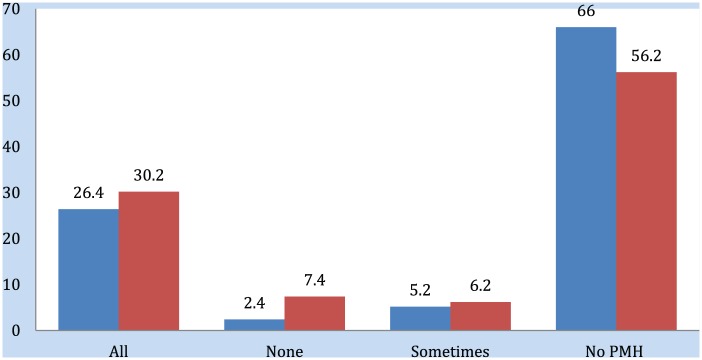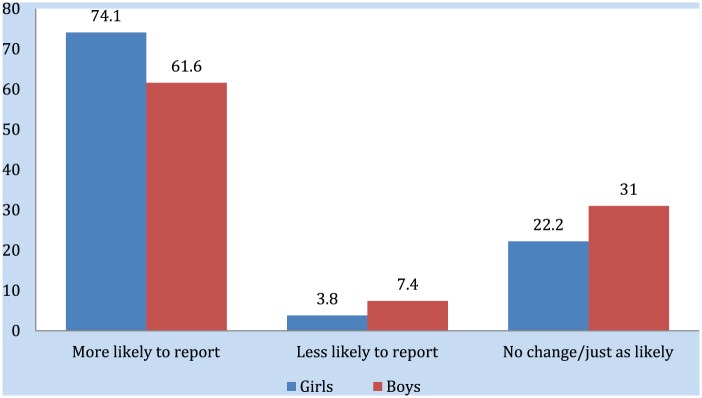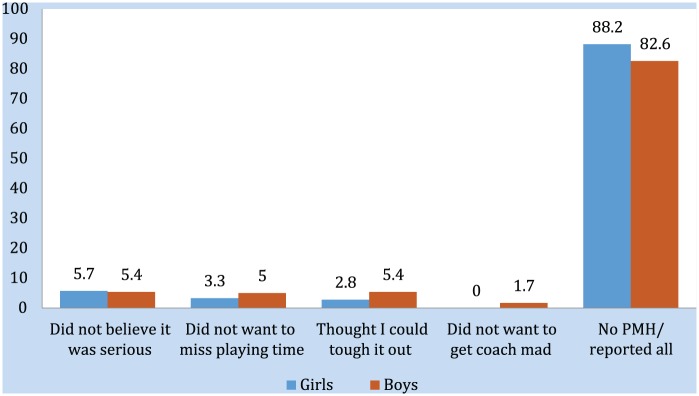Abstract
Background:
An athlete’s lack of concussion knowledge could lead to significant underreporting and injury mismanagement. To provide more effective management strategies of concussions in adolescent athletes, further examination of reporting behaviors is of critical importance.
Hypothesis:
The hypotheses for this study were as follows: (1) Girls are more likely to report concussion, (2) girls are more likely to report future concussions after an educational intervention, and (3) a difference in rationale for not reporting concussion will be found between sexes.
Study Design:
Cross-sectional, cohort design.
Level of Evidence:
Level 3.
Methods:
Survey answers were collected on 454 high school athletes (212 girls, 242 boys; mean age, 15.7 ± 1.15 years). Individual team meetings lasting approximately 30 minutes were held to collect data and provide an educational lecture. Participants were randomly provided an iClicker to submit a response to questions asked.
Results:
Girls were more likely to report a concussion (χ2 = 8.32, df = 3, N = 454, P = 0.040) and more likely to report future concussions after educational intervention (χ2 = 8.54, df = 2, N = 454, P = 0.014). There were no differences between sexes regarding rationale for not reporting a concussion (χ2 = 6.42, df = 4, N = 454, P = 0.170).
Conclusion:
There is concern these athletes still fail to understand the severity and potential sequelae of concussion injury. Both sexes cited that concussion is not a serious enough injury to warrant reporting to a medical professional.
Clinical Relevance:
High school athletes recover more slowly from concussions compared with college athletes; therefore, educating this population and promoting the importance of being knowledgeable regarding concussion recognition may increase reporting prevalence.
Keywords: concussion, reporting, sex, high school
Concussions and associated complications continue to garner the attention of the media, athletes, coaches, parents, and health care professionals. To recognize concussion, athletic trainers and other medical personnel often rely on athletes to self-report. As we continue to encourage the shift in mindset regarding concussion in the context of severity, from an inconsequential “getting your bell rung” to a serious threat to an athlete’s overall health and well-being, it is critical that medical personnel understand the driving forces for reporting concussion. Furthermore, understanding potential sex differences in reporting patterns is of equal importance to ensure the development of more effective concussion management strategies.
In the context of reporting behaviors, current research suggests there is significant underreporting of concussion among adolescent athletes, especially boys.9,10,16,18 Additionally, athletes report a greater number of concussion symptoms on a computer-based test when compared with verbal or written methods, suggesting that athletes are lying about the severity of their concussion injury.5 These reporting behaviors cause concern among medical personnel as adolescents have a protracted recovery rate when compared with an adult brain after concussion6 and are at greater risk for poorer outcomes.1,3,6,8
Knowledge and attitude toward concussion are associated with reporting behaviors in adolescent athletes, where improved knowledge of concussion injuries exhibited improved concussion reporting practices.13 Therefore, further investigation of potential sex differences in concussion reporting practices may necessitate customized educational intervention approaches.
The aim of this study was to determine sex differences in the reporting of concussions, specifically: (1) who is more likely to report concussion, (2) who is more likely to report future concussions after an educational intervention, and (3) whether there is a different rationale for not reporting concussion injury.
Methods
Participants
The university’s institutional review board, the high school district, and the high school district’s traumatic brain injury team approved this study. Data were collected on 454 high school athletes (212 girls, 242 boys; mean age, 15.7 ± 1.15 years) from 1 school district. Data from multiseason athletes were only included from their first session. Data were collected on 10 different sports, including football, cheerleading, boys’/girls’ soccer, boys’/girls’ basketball, wrestling, volleyball, and boys’/girls’ lacrosse.
Parental/guardian consent was obtained for minor athletes, and all participants signed an approved informed consent form prior to data collection.
Procedures and Data Collection
Individual team meetings were scheduled with the high school coaching staff, and investigators traveled to the different schools to collect data and provide an educational lecture. Meetings were held in either classrooms or team rooms at each high school.
Participants were randomly provided an iClicker (AV-iQ) for data collection purposes. The iClickers were not specifically assigned to students to ensure anonymity. The iClickers allowed students to submit a response (A, B, C, D, or E) to questions asked. All responses were totaled and collected in the primary investigator’s computer.
Customized survey questions were asked to obtain the background information and previous medical history (PMH) and to gain insight regarding the athletes’ personal perceptions and knowledge of concussion. After the questions regarding concussion perception, a brief educational summary of the specific aspects of concussion was provided. Construct validity was determined by providing the survey to 2 different groups for comparison analysis: a group of college students with no formalized education in concussion injuries and a group of senior-level athletic training students with formalized concussion education and training. The survey scores were compared between the 2 groups using a t test, and the senior-level athletic training students had a significantly greater mean rank, t(19) = 5.0, P = 0.000, d = 0.88.
The reliability of the instrument was assessed using a test-retest Pearson coefficient (r). A group of 15 college students participating in an introductory human movement science course were asked to complete the survey and were asked to take the same survey 12 days later. The educational lecture was not given to this population; however, students did score slightly higher on the retest (7.1) compared with the original test (6.9); there was still a high correlation between testing dates (r = 0.656).
Educational Lecture
A PowerPoint presentation (Windows) was used to deliver the educational lecture and the same information was provided to all teams (see PowerPoint presentation online, available at http://sph.sagepub.com/content/by/supplemental-data). Each educational session lasted approximately 25 minutes. Information for the educational lecture was derived from current research and position/consensus statements. The questions for data collection purposes were directly embedded into the PowerPoint lecture, allowing for better audience engagement. All sessions began with collection of background information from participants. After baseline questions, participants were asked their personal perceptions/knowledge regarding specific areas of concussion. After specific questions, basic information regarding the specific topic area of concussion was given. For example, after participants answered the question, “Do you believe concussions would have an impact on your learning/education,” we provided basic information on how concussions may impact their academic performance. Topic areas included in the educational lecture were: mechanism of injury, signs/symptoms, long-term side effects, impact on education/learning, baseline testing, and return-to-play (RTP) protocols. Questions used for data collection purposes were asked prior to the educational content, as the purpose of this study was not to assess the educational intervention.
Statistical Analysis
Data were analyzed using PASW, version 18. Chi-square statistics were used to analyze a majority of the variables collected. Statistical significance was established a priori as α ≤ 0.05.
Results
Female and male participants were significantly different in the reporting of their concussion injury (χ2 = 8.32, df = 3, N = 454, P = 0.040). Boys were more likely to not report a concussion injury (Figure 1). Female and male participants were also significantly different regarding whether they would be more likely to report a concussion after the educational intervention (χ2 = 8.54, df = 2, N = 454, P = 0.014). Girls reported being more likely to report future concussion injuries after an educational lecture (Figure 2).
Figure 1.
Percentage of girls and boys reporting concussion. PMH, previous medical history.
Figure 2.
Percentage of girls and boys regarding their likelihood to report future concussion after the educational intervention.
Female and male participants were not significantly different regarding their rationale for not reporting a concussion (χ2 = 6.42, df = 4, N = 454, P = 0.170) (Figure 3), their belief that the importance of a game/event should impact RTP decisions after a concussion (χ2 = 2.78, df = 1, N = 454, P = 0.095), and whether they would falsify the severity of a concussion to RTP more quickly (χ2 = 0.63, df = 1, N = 454, P = 0.429).
Figure 3.
Percentage of girls and boys on their rationale for not reporting concussion. PMH, prior medical history.
Female and male participants were not significantly different in the number of previous concussions they believe they sustained pre–educational intervention (χ2 = 6.71, df = 4, N = 454, P = 0.152) or after educational intervention (PMH was reassessed after the educational intervention) (χ2 = 6.312, df = 3, N = 454, P = 0.097).
While there was no difference between sexes and reported concussion history after the educational intervention, there was a difference within each population. Prior to the educational intervention, all participants were asked how many concussions they believed they had sustained in their life. After the educational intervention, the same question was asked. A paired-samples t test indicated that girls realized they sustained a greater number of concussions after educational intervention, t(211) = −9.49, P < 0.001, d = 0.65. The difference was statistically significant and considered typical using Cohen’s 1988 guidelines. A paired-samples t test indicated that boys also realized they had sustained a greater number of concussions after educational intervention, t(241) = −7.59, P < 0.001, d = 0.49. The difference was statistically significant and considered typical using the same guidelines (Table 1).
Table 1.
Percentage of PMH concussion injuries by sex before and after educational intervention
| 0 | 1 | 2 | 3+ | |
|---|---|---|---|---|
| Female: Before | 67 | 19.3 | 5.7 | 4.2 |
| Female: After | 36.8 | 28.8 | 22.6 | 11.8 |
| Male: Before | 57.9 | 27.3 | 6.6 | 2.5 |
| Male: After | 34.7 | 36.8 | 14.9 | 13.6 |
PMH, prior medical history.
Discussion
There are several variables that can be attributed to high school athletes’ reporting of a concussion injury. Girls were more likely to report possible concussions, and this coincides with previous reports,9,10 posing serious concern.11 Multiple concussions are associated with prolonged recovery times.1,4 Younger brains are more vulnerable and are at risk for poorer outcomes when compared with an adult brain,6 primarily because of the differences in the brain’s physiology.7,12
The most common rationale expressed for not reporting a concussion was the belief the injury was not serious. Similar, previous results found 69% of participants continued to play while still experiencing symptoms from a concussion.15 Additionally, high school football players often do not have appropriate knowledge of symptoms and the potential consequences associated with a concussive injury.2
Although nonsignificant, concerning results were seen when asked whether the importance of an event or game should dictate RTP decisions. Reporting was relatively equal, with 46.7% (n = 99) of girls and 54.5% (n = 132) of boys believing the game/event should dictate RTP procedures. These numbers are significantly greater than those reported in 200617 and suggest that high school athletes do not fully comprehend the serious nature of a concussion injury, leading to dramatic underreporting.10,17
While there were no differences between sexes pre- and postlecture regarding concussion history, both sexes reported sustaining more concussions after educational intervention. Expecting athletes to understand concussion is not appropriate; all clinicians should preface a request for concussion history with an explanation of concussion.16
Given the difference between sexes regarding reporting behaviors after educational intervention and the shared commonality in reporting rationale as well as RTP protocols, concussion education initiatives should continue to focus on improving attitudes and beliefs and promoting better care-seeking behaviors.14
Limitations
Only 1 school district participated in this study. Incorporating additional school districts would improve the generalizability of these results.
Conclusion
Understanding sex differences concerning perception of concussion can aid in recognition and treatment of concussion, especially in the high school athlete. Educating this population and promoting the importance of being knowledgeable regarding concussion recognition may increase reporting prevalence. Improving self-reported symptom presence and severity is important in protecting these individuals from returning to activity too soon and potentially sustaining a more severe secondary injury.
Supplementary Material
Footnotes
The authors report no potential conflicts of interest in the development and publication of this article.
References
- 1. Castile L, Collins CL, McIlvain NM, Comstock RD. The epidemiology of new versus recurrent sports concussions among high school athletes, 20015-2010. Br J Sports Med. 2012;46:603-610. [DOI] [PubMed] [Google Scholar]
- 2. Cournoyer J, Tripp BL. Concussion knowledge in high school football players. J Athl Train. 2014;49:654-658. [DOI] [PMC free article] [PubMed] [Google Scholar]
- 3. Covassin T, Elbin RJ, Harris W, Parker T, Kontos A. The role of age and sex in symptoms, neurocognitive performance, and postural stability in athletes after concussion. Am J Sports Med. 2012;40:1303-1312. [DOI] [PubMed] [Google Scholar]
- 4. Covassin T, Moran R, Wilhelm K. Concussion symptoms and neurocognitive performance of high school and college athletes who incur multiple concussions. Am J Sports Med. 2013;41:2885-2889. [DOI] [PubMed] [Google Scholar]
- 5. Cripps AE, Boham MD. Baseline concussion symptom scores vary by method of collection. Int J Athl Ther Train. 2015;20:46-51. [Google Scholar]
- 6. Field M, Collins MW, Lovell MR, Maroon J. Does age play a role in recovery from sports-related concussion? A comparison of high school and collegiate athletes. J Pediatr. 2003;142:546-553. [DOI] [PubMed] [Google Scholar]
- 7. Guskiewicz KM, Valovich McLeod TC. Pediatric sports-related concussion. PM R. 2011;3:353-364. [DOI] [PubMed] [Google Scholar]
- 8. Kostyun RO, Hafeez I. Protracted recovery from a concussion. Sports Health. 2015;7:52-57. [DOI] [PMC free article] [PubMed] [Google Scholar]
- 9. Meehan WP, Mannix RC, O’Brien MJ, Collins MW. The prevalence of undiagnosed concussions in athletes. Clin J Sport Med. 2013;23:339-342. [DOI] [PMC free article] [PubMed] [Google Scholar]
- 10. McCrea MH, Olsen G, Leo P, Guskiewicz K. Unreported concussion in high school football players. Clin J Sport Med. 2004;14:13-17. [DOI] [PubMed] [Google Scholar]
- 11. National Federation of State High School Associations. 2013-14 High School Athletics Participation Survey. http://www.nfhs.org/ParticipationStatics/PDF/2013-14_Participation_Survey_PDF.pdf. Accessed February 16, 2015.
- 12. Reddy CC, Collins MW, Gioia GA. Adolescent sports concussion. Phys Med Rehabil Clin N Am. 2008;19:247-269. [DOI] [PubMed] [Google Scholar]
- 13. Register-Mihalik JK, Guskiewicz KM, McLeod TC, Linnan LA, Mueller FO, Marshall SW. Knowledge, attitude and concussion-reporting behaviors among high school athletes: a preliminary study. J Athl Train. 2013;48:645-653. [DOI] [PMC free article] [PubMed] [Google Scholar]
- 14. Register-Mihalik JK, Linnan LA, Marshall SW, McLeod TC, Mueller FO, Guskiewicz KM. Using theory to understand high school aged athletes’ intentions to report sport-related concussion: implications for concussion initiatives. Brain Inj. 2013;27:878-886. [DOI] [PubMed] [Google Scholar]
- 15. Rivara FP, Schiff MA, Chrisman SP, Chung SK, Ellenbogen RG, Herring SA. The effect of coach education on reporting of concussions among high school athletes after passage of a concussion law. Am J Sports Med. 2014;42:1197-1203. [DOI] [PubMed] [Google Scholar]
- 16. Robbins CA, Daneshvar DH, Picano JD, et al. Self-reported concussion history: impact of providing a definition of concussion. J Sports Med. 2014;5:99-103. [DOI] [PMC free article] [PubMed] [Google Scholar]
- 17. Sye G, Sullivan SJ, McCrory P. High school rugby players’ understanding of concussion and return to play guidelines. Br J Sports Med. 2006;40:1003-1005. [DOI] [PMC free article] [PubMed] [Google Scholar]
- 18. Williamson IJ, Goodman DC. Converging evidence for the underreporting of concussions in youth ice hockey. Br J Sports Med. 2006;40:126-132. [DOI] [PMC free article] [PubMed] [Google Scholar]
Associated Data
This section collects any data citations, data availability statements, or supplementary materials included in this article.





